
When Apple bought Emagic in 2002, Windows users were, to put it mildly, gutted, as the new owner flatly stated that Logic Audio would never advance beyond version 5 on PC. Apple heads, on the other hand, were overjoyed.
Not only were their computers being designed in Cupertino, but now their DAW of choice was, too, implying not only rock-solid stability but also a symbiosis of hardware and software that could bring who knew what sort of game-changing features with it.
Since then, Logic Pro (the name was changed for version 6) has developed, certainly, but not exactly at the rate many hoped it would. With Steinberg and Cakewalk reliably packing ingenious new features and workflow enhancements into their annual Cubase and Sonar updates, and Ableton redefining the philosophy of what a DAW should be with Live, it's felt rather as if Apple has had its audio team spending the vast majority of its time on GarageBand - admittedly, a hugely worthwhile endeavor, but not one of great interest to serious music producers.
"Logic Pro can proudly consider itself an absurdly feature-rich and, in several areas, way-ahead-of-the-curve software studio once again."
Logic has moved on, certainly, but in comparison to what its peers have achieved in the same timeframe, the progress between Logic Pros 6 and 8 has been medium-paced at best, and in some areas, the application could be described as positively backwards next to the competition.
Until now! Logic Pro 9, we're happy to report, sees Apple truly bringing its problem child up to speed with what a professional DAW should be in 2009. Most of those niggling little 'legacy' issues have finally been resolved, some very well thought-out new workflow enhancements have been applied, and a considerable number of extraordinarily cool new features have been added.
Logic Pro can proudly consider itself a problem-free (well, as much as we could reasonably expect of any DAW), absurdly feature-rich and, in several areas, way-ahead-of-the-curve software studio once again.
And if you're looking for reasons why, we've got 10 of them right here...

1. Flex Time
Ever since Ableton burst onto the music software scene with its seminal Live DAW, every major developer has rushed to build its own take on 'elastic audio', and although it's taken Apple longer than most, its implementation is elegant and effective.
Simply activate Flex Time on an audio clip, select a Flex Mode (Slicing, Rhythmic, Monophonic, Polyphonic, Tempophone and Speed) and a marker is created at every transient point. Using the Flex Tool, markers can then be locked in place or dragged along the timeline, taking the attached transient with it and timestretching everything before and after it up to the previous or next locked marker.
Cleverly, the colour of each slice changes to show whether it's been stretched or compressed - orange for the former, green for the latter.
Since Flex Time has clearly required an overhaul of Logic Pro's entire timestretching engine, a few other useful features have come about as a result. Audio can now be quantised, for example, in exactly the same way as MIDI, with transient markers standing in for MIDI note events; Varispeed enables you to speed up or slow down your entire project just by activating Varispeed mode and changing the global tempo; and with Selective Track Import (more on this later) you can combine recorded tracks from different Logic projects, with everything conforming to the same tempo.
NEXT PAGE: Convert to Sampler Tracks, Amp Designer and Pedalboard
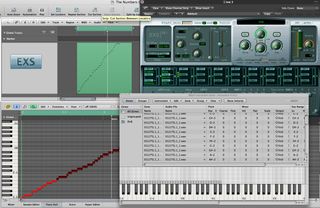
2. Convert to Sampler Track
The ability to trigger sliced audio loops with MIDI data is invaluable to many producers, and software instruments such as pHATmatik Pro and Stylus RMX have made such functionality available in plug-in form for several years.
Now Logic Pro has it built-in via the Convert to Sampler Track menu entry. This slices the currently selected audio clip, loads all the slices into an EXS24 sampler and creates a new MIDI track for it, with the requisite MIDI data in place.
Awesome, and also a much-needed shot in the arm for the excellent-but-a-tad-behind-the-competition EXS24 itself.

3. Amp Designer
Oh man, guitarists are gonna flip over this one. Amp Designer is a thoroughly comprehensive guitar combo design system, complete with adjustable mic positioning, built right into Logic Pro as a plug-in.
25 amps, 25 cabinets, five EQs and ten reverbs give an incredible range of sounds, and if you need a patch in a hurry, a vast array of presets is included, helpfully browsable by tone as well as type.
With its many hardware influences barely disguised graphically, early reports indicate that Amp Designer genuinely gives the likes of AmpliTube and Guitar Rig a run for their money in terms of sound.
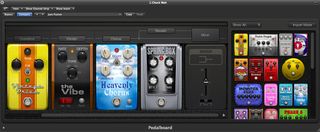
4. Pedalboard
Aimed at guitarists but no doubt destined to become a favourite of sound designers too, Pedalboard is the perfect complement to Amp Designer, comprising a modular rack of virtual stompboxes, 30 in total, including everything from distortion and overdrive to delay, reverb and modulation.
Again, the model on which each unit is based is generally apparent, and they can be laid out entirely in series or over two parallel channels, and pre- or post-mixer.
Pedalboard has been designed to work seamlessly with Apogee's imminent GiO controller, and the two should make a formidable combo live and in the studio.
NEXT PAGE: Drum Replacer, Notes and Space Designer's Warped Effects

5. Drum Replacer
Sort of like a minimal take on WaveMachine Labs' acclaimed Drumagog, Drum Replacer detects kick drums, snares, toms and 'Other' sounds in a drum track (based on frequency content and transients) and replaces or doubles them with alternative samples, which are loaded into an auto-created EXS24 sampler.
You can set the sensitivity of the transient detection and the pitch of the triggering MIDI note, and a big ol' library of bundled 'replacer' samples is included, its various folders opening in the Media browser automatically as each type of drum is selected in the Drum Replacer dialog.

6. Notes
Essentially a built-in Rich Text editor, Notes is a new pane in the browser area that enables you to enter formatted text notes (including HTML links) for your overall project and each individual track.
It's endlessly useful, and not only that, but the mixer now has a togglable 'scribble strip' area, into which even more notes can be added.
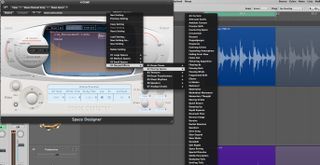
7. Space Designer Warped Effects
Space Designer's always been one of the finest convolution reverbs on the market, but it's a bit… conventional in terms of built-in Impulse Responses.
Logic Pro 9 throws in 450+ Warped Effects IRs. These range from weird drones and shifting spaces to 'Drum Transformers' and 'Ghost Rhythms', opening up a mental new world of sound design possibilities to fans of Logic's flagship effects processor.
NEXT PAGE: Bounce In Place, Selective Track Import and a few more little things

8. Bounce In Place
It's only taken Apple forever, but Logic Pro has finally been blessed with the ability to render the output of audio and instrument tracks as discrete audio files, automatically placed as regions directly in place in the arrange page.
It can be done per region, per track, or to every track in a project simultaneously; reverb and delay tails can be included in the bounced file and/or region; and since 'In Place' actually means 'on a new track below the original one' or 'on the currently selected track, which can't be the one hosting the region to be bounced', you can choose to mute, delete or leave the original. Not too shabby.
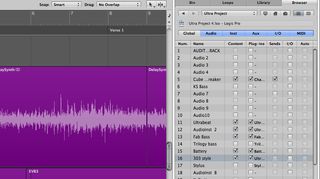
9. Selective Track Import
Logic Pro 9 can import individual tracks from one project into another. In the Media browser, browse to the Logic Pro project (which can be pre-v9) from which you want to import and simply check the boxes for the tracks to be brought into the current project.
As well as the regions on the track, you can also elect to import its plug-in instruments and effects, sends, I/O settings, automation and Track Notes.
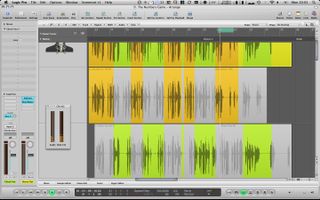
10. The little things…
As well as those headliners, Logic Pro 9 introduces countless smaller improvements and tweaks to workflow and usability. Multicore CPU support has been vastly improved, for example, as has Quick Swipe Comping, which now enables the moving of comps to new tracks without having to flatten them, as well as improved editing.
Somewhat less significant but no less welcome are such things as the facility to name and colour the dual mixer channels in the Inspector, the white keyline that now appears around the currently active pane in the GUI, and the movement of many menu entries to more sensible and intuitive locations.
All in all, the little things add up to a Logic experience that just feels more cohesive, polished and, dare we say it, logical.
So there you have it: MusicRadar's ten most exciting and intriguing new features in Logic Pro 9. For the full review of Apple's monstrous new package, get your hands on the October issue of Computer Music magazine, which goes on sale in the UK on 1 September.
Liked this? Then try:
14 vital Logic Pro 8 power tips
Evolving audio pads in Logic Pro 8
Sign up for our free weekly newsletter
The free MusicRadar newsletter serves up the week's biggest artist and product news stories alongside exclusive tuition and gear reviews. Sign up here!
Follow MusicRadar on Twitter
Get instant updates and bonus content plus chat with the team. Start here!
